AMD Launches Ryzen 5000 Mobile: Zen 3 and Cezanne for Notebooks
by Dr. Ian Cutress on January 12, 2021 11:52 AM EST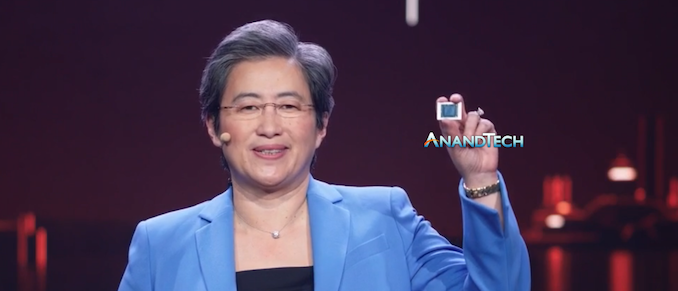
It has been a year since AMD launched its previous generation Ryzen Mobile processors. At the time, the update from Zen to Zen 2, as well as moving to TSMC’s 7nm manufacturing process, gave the company the biggest boost in its notebook performance and battery life in AMD’s history. It’s difficult to reinvent the wheel again, but AMD is hoping that its new Ryzen 5000 Mobile processors build on the momentum that started last year. The new processor line-up has 13 new models, targeting the traditional U series and H series markets, as well as a couple of new areas AMD is looking to expand into.
AMD Ryzen 5000 Mobile:
8 Cores of Zen 3
8 Compute Units of Vega
For those familiar with the previous generation of Ryzen 4000 Mobile, then the situation for these new processors is relatively simple: replace the Zen 2 cores with Zen 3 cores, combine the L3 cache, double the L3 cache, and that’s about it.
For everyone else, what we have here is a single piece of silicon that contains one group of eight Zen 3 cores that share a single 16 MB non-inclusive L3 cache. AMD’s big marketing tool for the other Zen 3 families on the desktop is that the size of the L3 cache effectively reduces main memory latency and helps gaming performance, and so with the new mobile processor they’ve combined the two four-core complexes into a single eight-core complex, then doubled the amount of cache, enabling each processor to have access to all the cache on the CPU at the same time.
These cache updates work in line with core updates that the Zen 3 core microarchitecture provides. We’ve covered the Zen 3 microarchitecture in our desktop processor review, which you can read here. Just replace the L3 cache numbers with 16 MB to get a sense of what the mobile processors will have.
For graphics, there are no updates moving from Ryzen 4000 to Ryzen 5000, and we still have eight compute units of Vega-era design. This will be a bit of a frustration for a few users that may have been hoping for some RDNA2 level updates to push performance along, especially with the added efficiency and performance gains that an RDNA2 design should have possibly brought to the table. The simple matter here is that when AMD put Vega on its Ryzen 4000 Mobile in 7nm, the efficiency was increased enough that enabled sustained development and kept AMD on cadence for its next generation. We’re at a stage now where AMD might consider updating the CPU/GPU on its APUs in alternate years, if that keeps the rate of product releases in line with its other designs.
For additional connectivity, we expect the Ryzen 5000 Mobile processors to also keep the same as the previous generation: eight lanes of PCIe 3.0, support for NVMe and SATA, and DDR4-3200 / LPDDR4X-4266. Again, leveraging the previous generation design helps AMD’s generational time-to-market (something that AMD has been saying it needs to keep track to), but we do perhaps expect updates next time around.
While we don’t have a Ryzen 5000 Mobile silicon die on hand (something we lose by not having a physical CES event this year, but totally understandable), because the Zen 3 cores are slightly larger than the Zen 2 cores, overall the die size of Ryzen 5000 Mobile should be slightly bigger. This should not have much of an effect on designs, depending on how the packages arrange their pin-out design. Given the similarities, it is possible for the pin-out to be identical to the previous generation.
All of AMD’s Ryzen 5000 Mobile processors (3 exceptions, listed below) are binned from this one silicon die design.
Ryzen 5000 Mobile, H-Series: H, HS, and new HX
AMD’s top tier mobile parts are all in the H-series. Traditionally these processors are listed with a TDP of 45 W, however last year we saw AMD experimenting with a newer 35 W category called ‘HS’. This year AMD is again introducing a new level called ‘HX’ for its overclocking models, going above the standard H-series TDP.
| AMD Ryzen 5000 Mobile: H-Series | |||||
| AnandTech | Cores Threads |
Base Freq |
Boost Freq |
TDP | Zen |
| Ryzen 9 5980HX | 8C / 16T | 3300 | 4800 | 45W+ | Zen3 |
| Ryzen 9 5980HS | 8C / 16T | 3000 | 4800 | 35W | Zen3 |
| Ryzen 9 5900HX | 8C / 16T | 3300 | 4600 | 45W+ | Zen3 |
| Ryzen 9 5900HS | 8C / 16T | 3000 | 4600 | 35W | Zen3 |
| Ryzen 7 5800H | 8C / 16T | 3200 | 4400 | 45W | Zen3 |
| Ryzen 7 5800HS | 8C / 16T | 2800 | 4400 | 35W | Zen3 |
| Ryzen 5 5600H | 6C / 12T | 3300 | 4200 | 45W | Zen3 |
| Ryzen 5 5600HS | 6C / 12T | 3000 | 4200 | 35W | Zen3 |
These two series, HS and HX, represent different strategies for AMD. Last year when HS was introduced, AMD stated that these 35 W models were special, requiring system design approval from AMD in order to have access to them, as they enabled the same base and turbo frequencies but at a much better efficiency point. This year that distinction seems to have dropped away a bit, with the HS models now simply giving the same turbo but lower base frequency than the standard H. Note that the change in TDP, from 45 W to 35 W, in the various TDP modes, typically relates to changes in base frequency, so in that instance AMD is more aligned with what the market is used to.
For HX, this changes AMD’s offering. Overclockable models in laptops isn’t necessarily new (Intel has done it for years), but AMD has taken the detail to explain that the TDP is raised to a ‘45W+’ design for these parts. This allows the OEM partners to ultimately define their TDP level, and have the sustained base frequency increased match expectations for the hardware it is built for. This means that desktop-replacement devices can fully turbo up to 65 W (or higher?) as needed, rather than those OEMs having to reply on building a socketed platform in a portable chassis.
Users might also note that the Ryzen 9 processors here do not have traditional H series parts. Because the mobile market is always a bit odd in its numbering scheme, the Ryzen 7 5800H takes that role, because it still has eight cores. If OEMs want the Ryzen 9 branding, they either have to build something sleeker for a 35W HS, or something beefier for the 45W+ HX.
AMD is advertising the Ryzen 9 5980HS as the best processor for portable gaming performance, whereas the Ryzen 9 5980HX as the best mobile processor for gaming. AMD showcases the 35 W model as scoring 600+ in Cinebench R20, in line with the desktop Zen 3 processors launched last year.
Ryzen 5000 Mobile: U Series (not all Zen 3)
The U-series portfolio is where AMD’s processor cycle updates cause a bit of bother. In a normal product cycle, we expect everything to be upgraded from the older to the newer, however this time around AMD is mixing and matching the U-series 15 W products between Zen 2 and Zen 3. So while there are new Zen 3 hardware options at 15 W, some of these processors are simply re-badges of Ryzen 4000 Mobile instead.
| AMD Ryzen 5000 Mobile: U-Series | |||||
| AnandTech | Cores Threads |
Base Freq |
Boost Freq |
TDP | Zen |
| Zen3 | |||||
| Ryzen 7 5800U | 8C / 16T | 1900 | 4400 | 15W | Zen3 |
| Ryzen 5 5600U | 6C / 12T | 2300 | 4200 | 15W | Zen3 |
| Zen2 | |||||
| Ryzen 7 5700U | 8C / 16T | 1800 | 4300 | 15W | Zen2 |
| Ryzen 5 5500U | 6C / 12T | 2100 | 4000 | 15W | Zen2 |
| Ryzen 3 5300U | 4C / 8T | 2600 | 3800 | 15W | Zen2 |
The top processor is the Ryzen 7 5800U, which is Zen 3, and there is also a Ryzen 5 5600U, which is also Zen 3. However, the others are Zen 2 based, using the same Renoir die as Ryzen 4000 Mobile.
Reasons for offering a re-badge can be confusing. Normally it is done to appease OEM partners that have a singular design and want to get the benefit of the latest generation nomenclature but not have the expense of developing a new unit. AMD’s public reasoning here has not been given, although in the past we’ve seen it beholden to its OEM partners (Carrizo and Carrizo-L) for this sort of co-design.
Despite this, AMD is promoting the Ryzen 7 5800U as its most efficient mobile processor to date, citing 21.4 hours battery life on a 53 Wh battery during 1080p video playback with Wi-Fi on, or 17.5 hours in MobileMark 2018’s battery life test. The footnotes state this was an AMD reference platform, though details on screen brightness were not given.
Overall, AMD is citing that they will have 150+ design wins this year for Ryzen 5000 Mobile, compared to 100+ for Ryzen 4000 Mobile. Availability for these systems, both the U-series and H-series, should start this February.


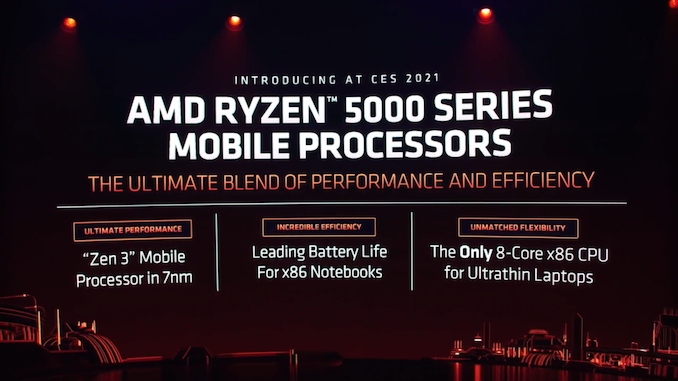
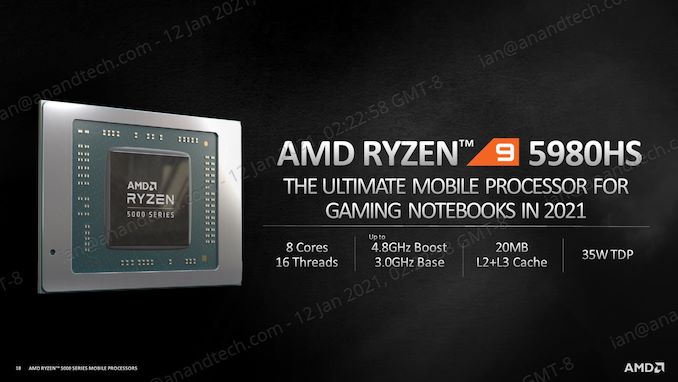
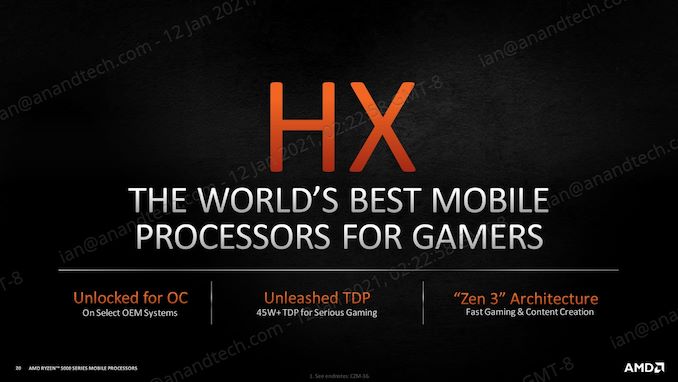
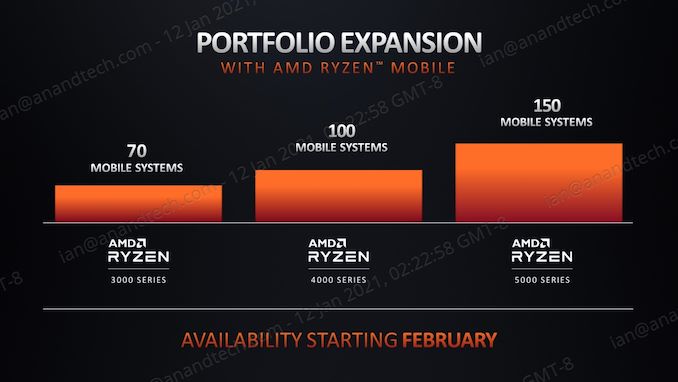








117 Comments
View All Comments
Bik - Tuesday, January 12, 2021 - link
Very true. But apple is still apple, with their closed eco system and their steep price. We may have to wait until Arm design reach that level.Exotic - Wednesday, January 13, 2021 - link
The MacBook Air M1 price is not steep at all for an ultrabook, similar priced ultrabooks for $999 can't match the level of performance and battery life is what the MacBook Air offers now.For $999 the M1 Mac is great for students and edu pricing puts it at $899. Way better than Dell or HP or Lenovo at the same range
romrunning - Tuesday, January 12, 2021 - link
re: Zen2 vs Zen3 - just remember for any 5000-series mobile, you should go for non-U processors first for peak performance. For battery life, if you get a U-series, only get the even-numbered ones.For the record, I hate the mixing in of Zen2 cores but keeping the 5000 numbering. I thought they were finally unifying everything under a common number, and then someone has to throw this in. Shame on whomever authorized that!
TheinsanegamerN - Tuesday, January 12, 2021 - link
M1 offers 15W APU performance. How does that effectthe much more capable 40 watt chips in any way?The Hardcard - Tuesday, January 12, 2021 - link
outside of Taiwan being hit with a huge meteor or a Chinese invasion, it is clear that higher core Mxx SOCs are imminent. iIt is possible that there is demand for all, however any unsold machines will be the x86 ones, likely Intel far more affected than AMD.Tams80 - Wednesday, January 13, 2021 - link
We don't know how we'll Apple's slipcovers will scale though.I think it will be the best, but mainly due to them integrating much more on the SoC.
And frankly, I'd rather sacrifice some performance on order to not have my RAM soldered on.
Kuhar - Wednesday, January 13, 2021 - link
Very true. If you do ever-day tasks on your computer (word processing, web surfing, youtube, instagram, twitter etc.). When you need multicore performance, large amounts of RAM (and possibly combined with some more serious GPU), AMD owns Apple in every possible scenario.Spunjji - Wednesday, January 13, 2021 - link
"At least Comet Lake vs Tiger Lake / Ice Lake had a different number of digits--how does Intel have less misleading model numbers versus AMD in 2020?"Yeah, that's annoying. It's clearly so that AMD and OEMs can utilise unsold Renoir inventory. I guess it's the same old story - if you're the sort of consumer that doesn't already know the difference between Cezanne and Renoir, then you probably won't notice the performance difference between Zen 2 and Zen 3 as much as the price difference between the models.
Nicon0s - Thursday, January 14, 2021 - link
I have to say these: no matter what AMD or Intel do Apple's M1 processor is still better" are quite amusing.I don't see how AMD would have faired better if they would have developed an ARM CPU, actually it doesn't make any sense to make such a claim. One of the main advantages of Zen processors is that they are an x86 arhitectue so they are fully compatible with the absolutely huge x86 software library.
As a current Windows laptop user I see no attraction for an ARM MacBook other than the fact that is has good battery life. I honestly would never give up my software, games libraries to move to an ARM MacBook in order to get better battery life.
People who believe that Windows laptops will massively lose sales in favor of these ARM MacBooks are simply delusional.
Ptosio - Saturday, January 16, 2021 - link
Plus, as per article, Zen 3 is claiming 20h+ battery life.And all that on one generation of process node behind. Once AMD gets access to 5nm (and that's TSMS's technology, not Apple's), it's not impossible that they can achieve similar runtimes on x86.
And the performance of mobile Ryzen is already more than adequate.
I for one, don't see the appeal of ARM UNLESS Windows and Linux would have full x86 emulation that would run at least as good as the original.